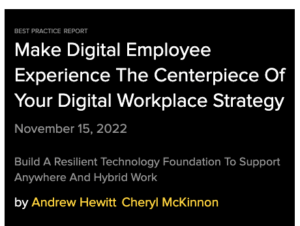What Are Key Components of Digital Employee Experience?
The Digital Employee Experience (DEX) has become increasingly vital in today’s fast-evolving work landscape, particularly as organizations embrace remote and hybrid work environments. DEX encompasses every aspect of an employee’s interactions with digital tools, technologies, and resources that enable them to accomplish their tasks. Understanding and optimizing that employee experience and interaction with technology is essential for driving employee productivity, engagement, and satisfaction, ultimately leading to business success.
Key components of DEX
A comprehensive approach to Digital Employee Experience involves five critical components:
- Application performance and usability: Ensuring applications are fast, reliable, and user-friendly to support employees in their day-to-day tasks.
- Device performance and reliability: Providing employees with devices that are high-performing, dependable, and tailored to their specific needs.
- Connectivity and network performance: Facilitating fast and stable network connections that allow employees to work efficiently and collaborate seamlessly.
- Workspace environment and collaboration tools: Creating a digital environment that promotes effective communication and collaboration among team members.
- Security and data protection: Implementing robust security measures to safeguard sensitive company and employee information.
The importance of DEM solutions
To effectively manage and enhance DEX, Digital Experience Management (DEM) platforms are the vital tool in that technology toolbox for IT leaders. This is why organizations that are looking to improve their employee experience partner with Riverbed to implement Alluvio Aternity DEM across their enterprise. Aternity provides visibility into the actual user experience of performance of applications, devices, and networks, enabling IT teams to proactively identify and address issues impacting employee experience.
Overall, DEM solutions like Alluvio Aternity play a crucial role in improving DEX by:
- Gaining real user insights into employee experiences with applications and devices
- Proactively addressing performance issues to maintain a seamless, productive work environment
- Optimizing IT infrastructure and resources to support employee productivity
- Evaluating the impact of IT initiatives on employee experience and business results
Organizations looking to improve their DEX should adopt these four best practices:
- Establish a baseline: Measure the current state of application performance, device health, and network connectivity to create a foundation for understanding and improving employee experience.
- Identify and address bottlenecks: Use data from DEM solutions like Aternity and direct employee feedback to proactively resolve performance issues and maintain a seamless, productive work environment for employees.
- Prioritize user-centric initiatives: Focus on improving employee experiences with digital tools and resources, ensuring your organization’s technology investments yield maximum returns in terms of employee satisfaction and productivity.
- Measure and monitor: Regularly measure and monitor DEX metrics to track progress and ensure continuous improvement. Encourage employee feedback and promote a culture of open communication to identify areas for improvement and drive positive change within the organization.
Leveraging Alluvio Aternity for enhanced DEX
Being in Product Marketing at Riverbed, I’ve seen firsthand how our solutions have helped organizations measure and optimize employee experiences. Alluvio Aternity DEM offers valuable insights into employee interactions with applications and devices. It measures the employee’s true, actual experience, enabling IT teams to proactively identify and resolve performance issues, optimize IT infrastructure and resources, and measure the impact of IT initiatives on employee experience and business outcomes.
By leveraging Aternity’s DEM capabilities, organizations can:
- Better understand the end-user perspective and identify opportunities for improvement
- Foster a culture of continuous improvement focused on enhancing employee experiences
- Streamline IT decision-making based on accurate and actionable insights
- Enhance collaboration and communication across teams and departments
As remote and hybrid work environments continue to become the norm, organizations must prioritize digital employee experience. By implementing a robust DEM solution like Alluvio Aternity and following best practices, organizations can unlock the full potential of their workforce, driving overall business success.
Emphasizing the importance of DEX in decision-making processes and technology investments will lead to a more engaged, productive, and satisfied workforce, which in turn positively impacts customer experiences and business outcomes. By focusing on continuous improvement and fostering a culture of open communication, organizations can stay ahead of the curve and thrive in today’s rapidly changing digital landscape.

Forrester recently published a best practices report, Make Digital Employee Experience the Centerpiece of Your Digital Workplace Strategy, where they emphasize how optimizing the digital employee experience (DEX) has become a critical factor for today’s diverse, hybrid workforce, and how improving employee experiences translates to better business outcomes. Forrester states that “while many organizations focus on tools to measure and enhance DEX, the path to success starts long before the tools discussions. Your strategy must embrace a flexible philosophy for happier employees. Then you can explore a variety of technologies to fulfill that vision.”
A comprehensive DEX solution like Alluvio Aternity is crucial for improving employee experiences and driving success in hybrid and remote work settings. You can download a complimentary copy of the Forrester Report here.

Leave a Reply